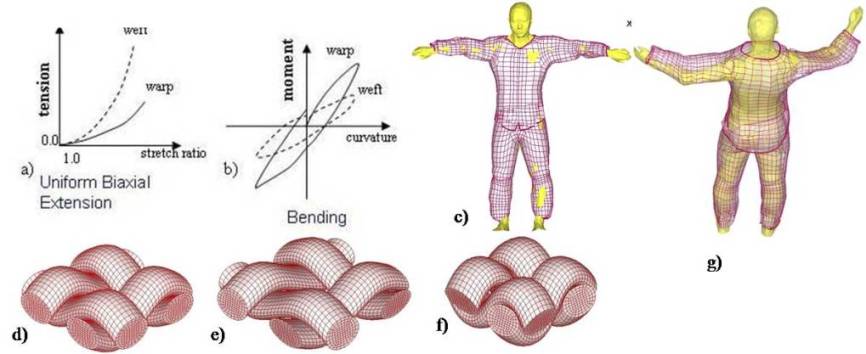In many circumstances, clothing adversely impacts human performance while also providing protection from
exposure to a wide spectrum of external hazards. Our research objective is to realistically describe
clothing with computational models and to then exercise these models to realistically predict how different
types of clothing (of varying fabrics, cut, and fit) impact human performance when engaging in physical
tasks such as running, climbing, walking, etc. With a knowledge of how clothing impacts human performance,
the clothing can be re-designed to improve performance. This research combines many long-standing issues in
solid mechanics such as the following:
- modeling of very flexible systems (clothing) as shells and membranes at arbitrarily large deformations;
- contact modeling between clothing and the human, and self-contact between portions of the same garment;
- developing suitable constitutive models that account for the fibers comprising the fabric, and their
evolving woven or knitted structure in the garment;
deformation of the fabric, and this needs to be captured in fabric constitutive models, since it impacts the
incremental stiffness response of the fabric (Fig. 1).

Figure 1. a) Schematic of tension vs. stretch behavior of fabric showing both nonlinearity and hysteresis;
b) Schematic of hysteresis in moment-curvature response of fabric; c) human-scale fabric model;
d) undeformed unit cell model of plain-weave fabric; e) biaxially stretched unit cell; f) biaxially
compressed unit cell; and g) virtual mannequin clothed with a mathematical clothing model.
- Video: Pulling oversized pants on, followed by shrinking to fit.
- Video: Pulling properly sized pants on.
- Video: front view initial drape of full-body clothing onto X-mannequin
- Video: rear view initial drape of full-body clothing onto X-mannequin
- Video: response of shirt to strong upper body twist by the X-mannequin
- Video: pants with striding/overstepping legs (side view)
- Video: pants with striding/overstepping legs (front view)
- Xmannequin driven by mo-cap data (front view).
- Xmannequin driven by mo-cap data (rear view).
- Walking Xmannequin driven by predictive dynamics
- Stair-climbing Xmannequin driven by predictive dynamics
- Lindsay walking (front view) driven by predictive dynamics
- Lindsay walking (ortho view) driven by predictive dynamics